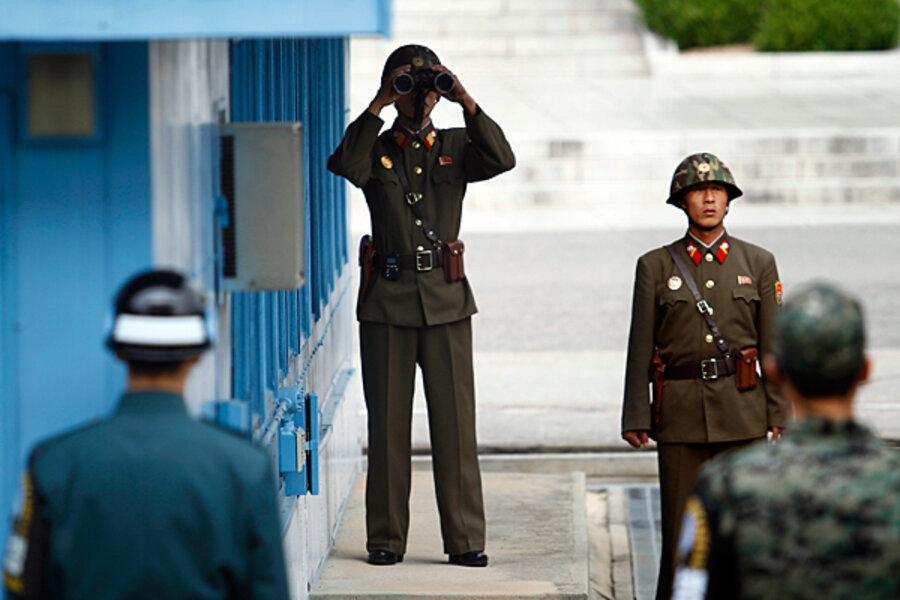North Korea threatens US after it helps South Korea
Loading...
| Manila, Philippines
North Korea boasted Tuesday that the United States was “within the scope” of its long-range missiles after South Korea vowed to deploy new missiles capable of reaching anywhere inside the North.
North Korea’s National Defense Commission, the country’s most powerful ruling body, issued the threat in response to an agreement between the US and South Korea for the South to increase the striking distance of its missiles to 500 miles, nearly triple their current range.
The North’s Korean Central News Agency quoted a spokesman as saying the North was ready to combat a “nuclear” attack by the US with “nuclear” weapons and to deploy “missiles against missiles.”
The question, however, is whether the furor over missiles – both South and North Korean – really marks another step on the way to a much more serious confrontation, including the risk of a second Korean War, or is simply another exercise in a long-running game of dare and double-dare.
“The North Koreans are trying to use their nuclear and missile programs as a panacea for their internal systemic problems,” says David Straub, a former senior diplomat in Seoul, South Korea, now associate director of the Korean studies program at Stanford University in California. “They want to reset the strategic chessboard and force South Korea, the United States, and others to deal on North Korean terms.”
By extending its own missile range, South Korea “answers that effort strategically," Mr. Straub says.
South Korean officials pressured the US for years to revise an agreement limiting the range of their missiles before the US finally agreed. Under terms of the 2001 agreement, South Korean missiles could reach targets no farther away than 300 kilometers (186 miles).
As for North Korea, it has an assortment of short- and medium-range missiles and has tested a long-range Taepodong missile in August 1998 with a theoretical range as far as the US West Coast. That missile flew over Japan, landing in the western Pacific south of Vladivostok, Russia. North Korea has also twice tested long-range Taepodong missiles that plummeted into the sea shortly after takeoff – most recently two days before the massive celebration on April 15 marking the centennial of the birth of "Great Leader" Kim Il-sung, grandfather of the North's current leader, Kim Jong-un.
North Korea is assumed to be developing the capacity to attach warheads to missiles but is believed to be far from achieving that goal.
Rising confrontation
A sense of rising confrontation with North Korea, however, has added urgency to the whole issue of South Korean missile development. South Korean President Lee Myung-bak ordered defense officials to produce long-range missiles as quickly as possible at a cost of more than $2 billion. South Korea is expected to be able to deploy new model missiles within five years under terms of what South Korean officials call a “landmark” deal with the US.
The US was extremely reluctant to accede to South Korean demands for fear of increasing tensions on the Korean Peninsula but yielded in view of mounting threats by North Korea – especially in the Yellow Sea, the scene of a series of bloody incidents in recent years. The rhetoric from North Korea has increased markedly since the death of long-ruling leader Kim Jong-il last December.
No one is certain, however, whether North Korea, under his son, Kim Jong-un, is seriously considering attacks such as those in the Yellow Sea in 2010 that killed 50 people, including 46 sailors, when a South Korean military ship was sunk by a torpedo fired by a North Korean midget submarine. Mr. Kim has been regularly visiting military units, often making strong statements, but also seems anxious to focus on the country’s overwhelming economic problems.
‘Blow to global nonproliferation?’
Mark Fitzpatrick, a former nonproliferation expert at the State Department now with the International Institute for Strategic Studies in London, worries that “the deal is a blow to the global nonproliferation regime.”
Nonetheless, he says, increasing the range of South Korea’s missiles “won’t necessarily deepen the confrontation on the Korean Peninsula since South Korea and its American ally already could reach any target in North Korea.”
One major reason for the deal was President Lee's need to buttress his image at a time when his political popularity has been sagging. Although he cannot run for a second five-year term in the presidential election coming up in December, he would like to see his hard-line policy toward the North continue under the conservative candidate, Park Geun-hye, daughter of Park Chung-hee, the long-ruling South Korean dictator who was assassinated by his intelligence chief in 1979.
The goal for South Korea “was more for political effect than actual deterrence,” says Victor Cha, a professor at Georgetown who served on the National Security Council during the presidency of George W. Bush. While Americans were concerned about “raising security threats in the region with Japan and China,” says Mr. Cha, “this deal seems to meet South Korea’s political needs to show they are ‘doing something’ to enhance deterrence.”
South Korea’s top military commander, Gen. Jung Seung-jo, says the deal is needed as long as North Korea threatens to take over islands in the Yellow Sea that are within eyesight of North Korea’s southwestern coast.
If the North occupies any of the islands, says Jung, chairman of the South’s joint chiefs of staff, “we will surely have to take them back, and we now have proper countermeasures in place.”
Ominously, he adds, the South is “considering a preemptive strike if North Korea shows signs of using nuclear weapons.”
Straub sees South Korean "nationalism" at play in the missile agreement. “The South Korean establishment was bound and determined to get this from the United States.”





